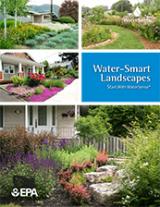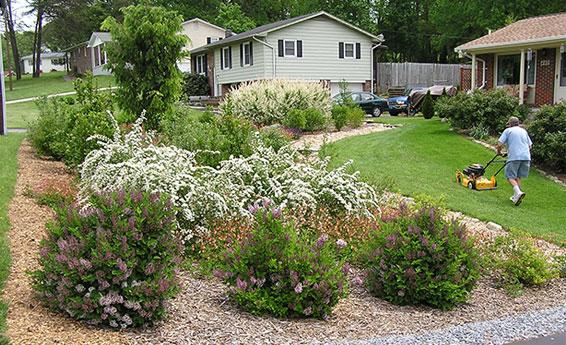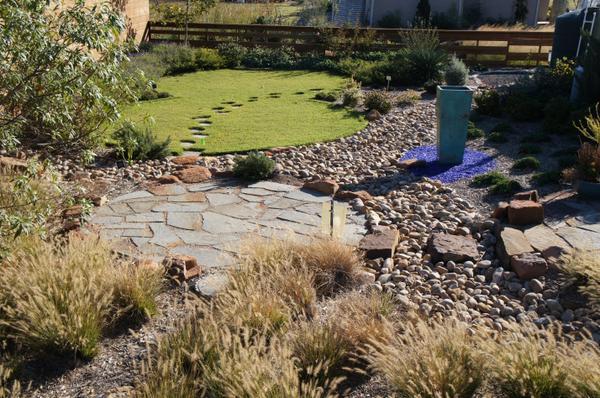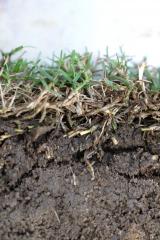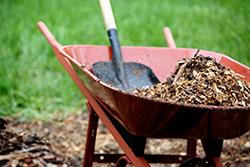Landscaping Tips

Are you interested in developing a water-smart landscape for your home or property? The WaterSense Water-Smart Landscapes guide (14 pp, 2.3 MB, About PDF) can get you started. Choosing the right plants, supporting soil health, and proper maintenance are all keys to water-smart landscapes.
On this page:
See Yourself in Your Landscape
The design you choose for your landscape will be influenced by how you want to use it and what other benefits you desire. Lawns can be the perfect place for the kids to play or for pets to run around on, but they may need maintenance more often. Shade trees can keep your landscape cool during sunny weather. A landscape with colorful shrubs can provide curb appeal. You may look for a combination – turfgrass for the kids, shrubs to form a border, a rain garden to prevent flooding, and trees for shade.
When planning your landscape design, in addition to primary use, also consider factors such as local climate, sun and shade locations, and the maintenance schedule. This plays a big part in how often your landscape receives rainfall and whether your plants must be prepared for a warm climate or cool climate. Although the plant choice will depend on region, you can still have an attractive, functional landscape with water-efficient plants. If you're designing a new landscape or rethinking your current one, the WaterSense Water Budget Tool can help you plan your landscape for water efficiency and tell you if you have designed a landscape that will use an appropriate amount of water for your climate. The WaterSense What to Plant page can help you find the right plants based on your state.
Northeast
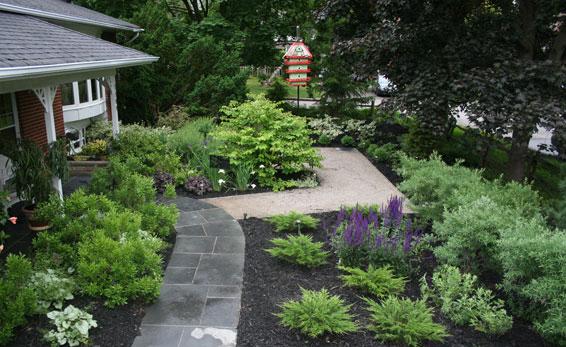 To create this lush landscape, the owners replaced turfgrass with a granite walkway and native plants, with a focus on drought-tolerant grasses native to the Northeast U.S. Now established, these plants require no water beyond normal rainfall.
To create this lush landscape, the owners replaced turfgrass with a granite walkway and native plants, with a focus on drought-tolerant grasses native to the Northeast U.S. Now established, these plants require no water beyond normal rainfall.
Midwest
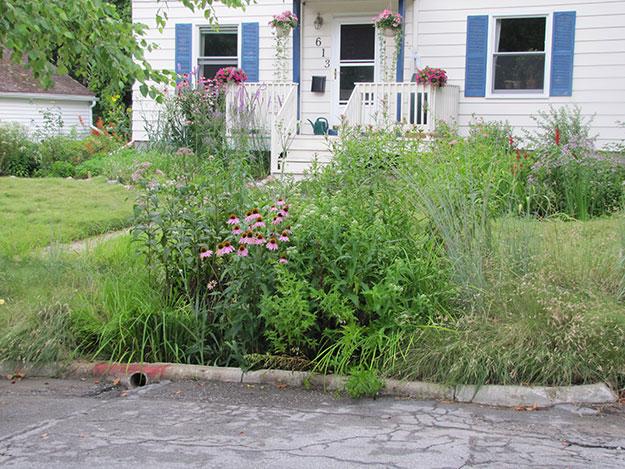 This front yard incorporates a rain garden populated with plants native to Michigan, uses stormwater runoff to meet its water needs, and leaves turfgrass space for the kids to run and play. Using a conduit installed in the curb, stormwater is diverted from the street and into the rain garden.
This front yard incorporates a rain garden populated with plants native to Michigan, uses stormwater runoff to meet its water needs, and leaves turfgrass space for the kids to run and play. Using a conduit installed in the curb, stormwater is diverted from the street and into the rain garden.
Northwest
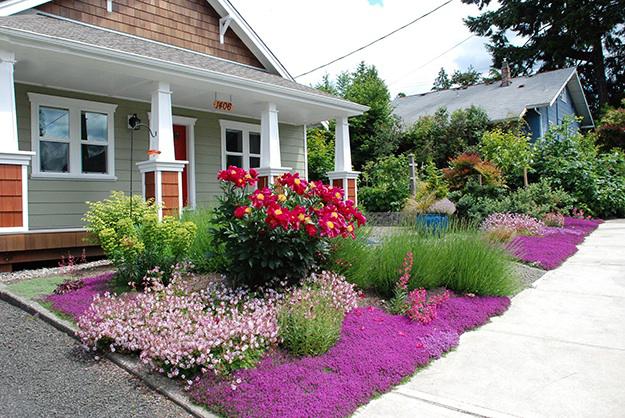 This compact, no-turf landscape features edibles, drought-tolerant plants, and a unique patio of permeable crushed rock and cobalt recycled glass aggregate. Drip irrigation efficiently waters the edible plants.
This compact, no-turf landscape features edibles, drought-tolerant plants, and a unique patio of permeable crushed rock and cobalt recycled glass aggregate. Drip irrigation efficiently waters the edible plants.
West
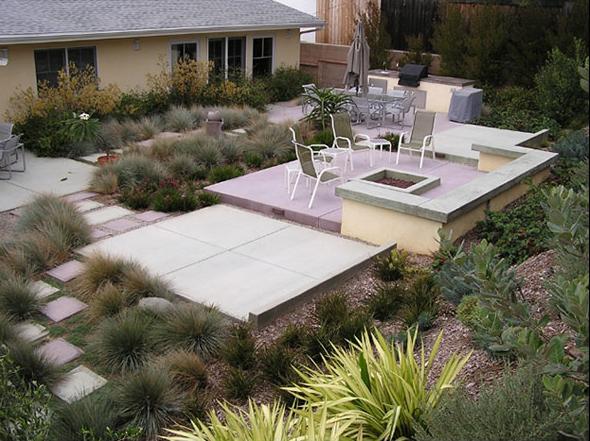 This backyard was designed for entertaining with a series of patios that allow water to permeate into the soil. Native, low-water-using plants retain the slope at the back of the property and fill in between patios. A drip irrigation system with weather sensors and timers minimizes water waste.
This backyard was designed for entertaining with a series of patios that allow water to permeate into the soil. Native, low-water-using plants retain the slope at the back of the property and fill in between patios. A drip irrigation system with weather sensors and timers minimizes water waste.
Take a look at our landscapes gallery for other ideas!
Also, as you look at your landscape, consider if a rain garden would be a good fit. Water running off your landscape and roof can become stormwater runoff which can harm local waterways as it picks up pollutants on its path. Rain gardens help to hold water on your landscape, helping you to reduce stormwater runoff and the need for supplemental irrigation. EPA New England’s Soak Up the Rain program has information on rain gardens. The Rain Garden app Exit, developed by the Connecticut NEMO (Nonpoint Education for Municipal Officials) program, can teach you how to build a garden and also has information for 23 states on appropriate plants to include in a garden.
Soil and Site Conditions
Keep your soil healthy!
Healthy soils cycle nutrients effectively, minimize runoff, retain water, and absorb excess nutrients, sediments, and pollutants. Have your soil tested for nutrient content, pH, soil composition, and organic matter content. Contact your local Cooperative Extension Office Exit or state universities for a soil test kit or soil testing services. Very sandy soil, heavy clay, compacted soil, or extreme soil pH may impact which plants are right for your yard. In these cases, seek advice from a nursery, horticulturist, Cooperative Extension, or other expert.
Aerate your soil.
Soil can become compacted during home construction or from normal foot traffic. Aerating your soil with a simple lawn aerator can increase the infiltration of water into the ground, improving water flow to the plant's root zone and reducing water runoff.
Use mulch to save water and improve soil health.
In addition to making landscapes attractive, mulch adds an extra layer between plant roots and air, helping to protect plants in a variety of ways. Mulch helps reduce evaporation, which allows soil to retain water longer and means plants require less frequent watering. Mulch also helps plants thrive by inhibiting weed growth, preventing soil erosion, and moderating soil temperature.
Different plants require different soil conditions, so it’s best to choose a mulch type based on plant varieties and their soil needs. Organic mulch such as hardwood chips, straw, leaves, pine needles, or grass clippings will help improve the condition of soil, by adding nutrients as it decomposes. Inorganic mulches like rocks, pebbles, or gravel may help to eliminate weeds. Avoid using rock mulches in sunny areas or around non-arid climate plants, as they radiate large amounts of heat and promote water loss that can lead to scorching.
Applying mulch to a depth of three to four inches provides the right coverage for most plants; excessive amounts of mulch can restrict water flow to plant roots. Leave a few inches of space between organic mulches and the base of trees or other woody plants to prevent rot. Don’t forget to pull any weeds prior to mulching and spread evenly to prevent thin areas where the mulch can’t do its job. The eXtension program Exit(part of the Cooperative Extension System) has additional information about mulch and water conservation.
Minimize steep slopes.
Slopes can be challenging because of the potential for erosion and runoff. If slopes cannot be avoided in your landscape design, install plantings with deeper root zones such as native ground covers and shrubs to provide stabilization and prevent erosion.
Use soil amendments where appropriate.
Soil amendments can be organic or inorganic. They are mixed into the soil and can provide short-term and long-term water saving benefits. Plants require water in the soil to grow healthy and soil amendments help the soil to retain moisture so that you do not have to irrigate as often.
Plants
Use regionally appropriate, low water-using and native plants.
Once established, these plants require little water beyond normal rainfall. Also, because native plants are adapted to local soils and climatic conditions, they rarely require the addition of fertilizer and are more resistant to pests and diseases than are other species. Be careful when selecting exotic species, as some may be invasive, which may require more water and could displace native plants. State affiliates of Plant Something Exitmay be able to point you in the direction of nurseries in your state who can assist you on plant selection and provide other advice.
If your landscape includes turfgrass, place it strategically in areas where it will have a practical function, and consider using a low-water-use turfgrass suited to grow in your local climate to provide a beautiful lawn that can save water. Our Turfgrass and Water Efficiency page provides information on types of turfgrass and tips on how to maintain a healthy lawn.
Recognize site conditions and plant appropriately.
Areas of the same site may vary significantly in soil type or exposure to sun and wind, as well as evaporation rates and moisture levels. Placing plants that prefer shade in open sun will affect their ability to thrive. Be mindful of a site's exposure to the elements and choose plants that will thrive in the site's conditions.
Group similar plants together for irrigation.
Grouping vegetation with similar watering needs into specific "hydrozones" reduces water use and protects the plants from both underwatering and overwatering by allowing you to water to each zone's specific needs. For example, turf areas and shrub areas should always be separated into different hydrozones because of their differing water needs.
Tips for starting new plants.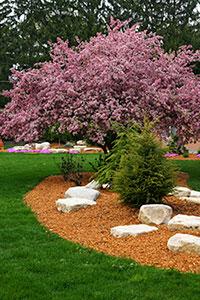
When trees and shrubs are planted, they will normally require irrigation during the establishment period. Once the plants have taken root, irrigation can be reduced and or eliminated. It is also common to surround the plant with a berm that holds the water at the base of the plant, preventing it from flowing away.
Turfgrass sod, plugs, or sprigs are mature plants that are directly planted into the landscape and establish quickly. The quick establishment period is a benefit to using sod, although the cost of installation can be higher than using seed. Seeding the landscape has a lower cost but could take longer to establish. Additional considerations related to turfgrass are on the Turfgrass and Water Efficiency page.
Maintenance
Irrigate only when needed.
Irrigating lawns has been a concern of water providers over the years due to the increased demand for water. From sports fields, to residential landscapes, to commercial properties, the use of turfgrass may require irrigation to maintain a healthy, useable landscape. Regions with higher temperatures and lower than average rainfall can provide more stress to the grass, causing it to brown. Grasses that are drought tolerant are better equipped to handle drought conditions requiring less frequent irrigation. Using smart watering practices will keep your landscape healthy and water use down.
Keep up with the weeding.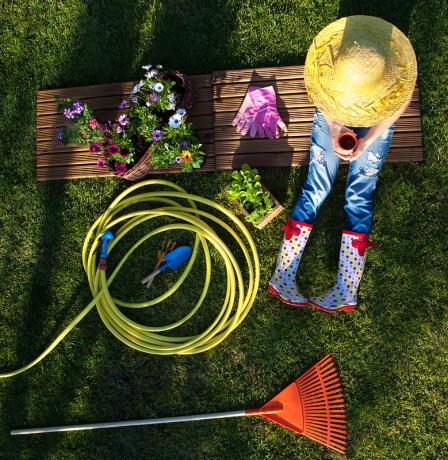
Make sure you regularly maintain your landscape. Replace mulch around shrubs and garden plants to help them retain moisture. Remove weeds and thatch as necessary so they don’t compete with your desired plants for water.
Raise your lawn mower cutting height.
Raise your lawn mower blade, especially in the summer, when mowing too close to the ground will promote thirsty new growth. Longer grass promotes deeper root growth and a more drought resistant lawn. Longer grass blades also help shade each other, reducing evaporation, and minimizing weed growth. The optimal turfgrass height is the tallest allowable height within the recommended mowing range for the turf species grown. The Turfgrass and Water Efficiency page has more information about proper management of turfgrass.
Minimize or eliminate fertilizer.
Fertilizer encourages thirsty new growth, causing your landscape to require additional water. Minimize or eliminate the use of fertilizer where possible. If you do need fertilizer, look for a product that contains "natural organic" or "slow-release" ingredients. These fertilizers feed plants slowly and evenly, helping to create healthier plants with strong root systems and no excessive "top growth". Moreover, using "slow-release" fertilizers can reduce nutrient run-off into ground and surface waters, protecting natural resources.
Grass clippings from mowing, when left in place, are a good natural source of fertilizer for the soil and can reduce the overall total fertilizer application required. A lawn with healthy turfgrass that is not cut too short will also be a good defense at preventing the growth of weeds.

